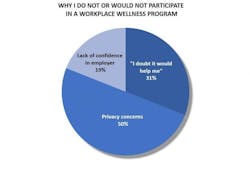Health and wellness is an important issue to any section of the labor pool, but even more so to truck drivers – largely because truck drivers are in poorer health than much of the U.S. population, for example exhibiting higher rates of smoking, obesity, and diabetes.
[Though poor truck driver health doesn’t necessarily equate to a higher crash risk, as this story explains.]Yet one key resource for boosting worker health – company wellness programs – is falling into a “black hole” of sorts in terms of employee usage.
Indeed, if a new survey is any guide, though such programs have become widely available throughout the U.S. business community, few workers even know they exist. And if they do know they exist, employees often avoid them due to privacy fears.
Though the survey conducted by Brodeur Partners is very small – a poll of just 542 adult Americans back in June – the firm weighted its study based on U.S. Census data to reflect the exact demographic profile of gender, age and region of the national population.
Based on Brodeur’s poll, only approximately one-third (34%) of employed Americans said they have a health and wellness program at workplace – in stark contrast to a recent study by the Society for Human Resource Management, which puts the prevalence of such programs at 70%."Clearly, there's a disconnect," noted Andrea Coville, Brodeur’s CEO. "Either employees aren't getting the memo about the programs that exist in their workplaces, or they don't consider what their employers are offering to be true wellness programs.”
Coville (at right) added that Brodeur’s findings buttress other research documenting this workplace wellness program “disconnect.” For example, according to Gallup, while more than 85% of companies with more than 1,000 employees offer a wellness program, only 60% of U.S. employees are aware that their company offers one.
Lack of awareness isn't the only explanation for an employee indicating their company lacks a wellness program, she stressed.. Sometimes there's just no program. And the likelihood of that seems to increase with an employee's age.
Only 32% of those age 35 to 54 and only 24% of the 55-plus segments indicated they had a workplace wellness program compared to more than 2 in 5 millennials (aged 18 to 34).
In theory, workplace wellness programs are designed to improve employees' health and productivity while reducing healthcare costs. By way of health risk assessments, help managing chronic conditions, and coaching for a healthier lifestyle.
Yet as good as these offerings sound, Brodeur’s survey found some employees resist them. The reasons include privacy concerns (50%), doubt that such programs would be helpful to them (31%), and lack of confidence in an employer's ability to run an effective program (19%).Brodeur also found that likelihood of resisting workplace wellness programs increases with an employee's age.
Though fewer than 1 in 3 millennials (27%) said they either do not participate in their workplace wellness program or would not if their workplace had one, resistance jumps to over 36% for Gen X and nearly half (45%) of the 55-plus baby boomer generation.
"This is a troubling inversion, but there's an opportunity here," stressed Coville. "Older workers, given that they are at higher risk for many conditions, are likely to deliver the biggest return on investment in a wellness program.”
Interesting, Brodeur’s survey did discern some “pent-up demand” for wellness programs, too. Nearly half the respondents to its poll (45%) said they would participate if their workplace offered a wellness program, including 46% of millennials, 47% of Gen Xers and 39% of baby boomers.
"Like a lot of our research, these findings reveal stark generational differences in attitudes," noted Jerry Johnson, Brodeur executive VP of planning, who led the research. "Understanding and systematically addressing these differences is the key to changing not only minds, but behavior around workplace wellness."
It’s a big mountain to climb, no doubt. But if the payoff is healthier workers and less money spent treating chronic illnesses and other side effects of poor health – especially for those in charge of piloting big rigs on our highways – it’s a mountain that should be climbed, and quickly.






